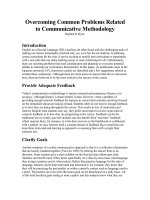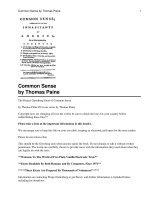COMMON ARTERIAL TRUNK
Bạn đang xem bản rút gọn của tài liệu. Xem và tải ngay bản đầy đủ của tài liệu tại đây (7.94 MB, 25 trang )
COMMON ARTERIAL
TRUNK
Nguyễn Thị Thu Trang
CK1-K25
Terminology
• Common arterial trunk (CAT)
• truncus arteriosus
• truncus arteriosus communis
• aorticopulmonary trunk
Introduction
Common arterial trunk (CAT) is characterised by a single great artery
arising from the base of the heart, which supplies the systemic,
coronary, and pulmonary blood fow. A large ventricular septal defect
(VSD) is almost always present in this anomaly, resulting from the
nearly absence of the infun dibular septum.
It accounts for up to 2% of congenital cardiac anomalies.
Embryology
• CAT results from
failure of the truncus
swellings, which
normally divide the
truncus arteriosus into
the aorta and
pulmonary arteries
during embryogenesis,
to fuse, resulting in a
persistent common
trunk
CLASSIFICATION
CLASSIFICATION: Collett and
Edwards
CAT is classified into four types by Collett and Edwards, based on the
anatomic origin of the pulmonary arteries
- Type 1: a short pulmonary trunk arises from the CAT and divides
into right and left pulmonary arteries
- Types 2 and 3, both pulmonary arteries arise separately, as
individual branches, from the CAT and they are either close
anatomically (type 2) or at some distance from one another (type 3)
-Type 4: the pulmonary arteries arise from the aortic arch or the
descending aorta, now reclassified as pulmonary atresia with VSD
rather than CAT.
CLASSIFICATION: Van Praagh
• type A1 is similar to type 1 of Collett and Edwards’s classification.
• type A2 combines types 2 and 3.
• type A3: origin of one branch pulmonary artery (usually the right)
from the common trunk, with other lung supplied either by
collaterals or a pulmonary artery arising from the aortic arch.
• type A4 refers to abnormalities of the aortic arch, including complete
interruption.
Imaging
• The root of the CAT is large and has a biventricular origin in most cases (overrides
the septal defect).
• The CAT valve has three leafets (tricuspid) in about 69% of cases, four leafets
(quadricuspid) in 22% of cases, two leafets (bicuspid) in 9% of cases. The valve
leafets are thickened (dysplastic).
• detecting a malaligned VSD with an overriding large vessel on the five-chamber view.
• absence of a separate pulmonary artery and valve arising from the right ventricle.
• Confirming the diagnosis is usually made by identifying the pulmonary trunk (or
arteries) arising directly from the overriding large vessel In the five-chamber view.
• The four-chamber view appears often normal in CAT
Associated Anomalies
Variations in coronary artery anatomy can add significant complexity and
risk to repair and are relatively common.
Coronary ostia can originate in various positions
Anomalous origin of the left coronary artery from the right coronary
will cross the RV outflow tract (RVOT)
Structural abnormalities of the truncal valve: three cusps, four cusps and
two cusps.
VSD
DiGeorge syndrome: Chromosome 22q11 Deletion
The aorta and main pulmonary artery share a common trunk, which
bestrides a high ventricular septal defect. Findings are compatible with
truncus arteriosus (Collett & Edwards type I or Van Praagh type A1).
Color Doppler
• Color Doppler may be helpful but is not necessary for the diagnosis of
CAT.
• demonstration of the shunt across the VSD
• dysplastic truncal valve is a common finding in this anomaly, truncal
valve regurgitation in diastole is often demonstrated in color Doppler
• In CAT types 2 and 3, color Doppler helps to identify the origin and
course of the right and left pulmonary arteries.
Figure 26.11: Gray scale (A) and color with spectral Doppler (B) of the five-chamber view in a fetus
with common arterial trunk (CAT) with dysplastic valves (same fetus as in Fig. 26.4). A shows
thickening of the valve leafets (arrow). B demonstrates severe holodiastolic valve regurgitation on
color (red) and spectral Doppler in diastole.
DiGeorge syndrome
• characteristic features of
Di George syndrome were
present: hypocalcaemia,
T cell abnormalities, and
overt thymic hypoplasia
DiGeorge syndrome
OUTCOME
/>
Thank you!









